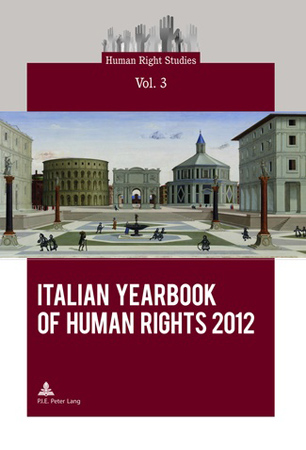Raccolte

Italian Yearbook of Human Rights 2012
- Tipologia pubblicazione
- Annuario italiano dei diritti umani
- Casa editrice
- Peter Lang International Academic Publishers
- Città
- Bruxelles
- Pagine
- 387
- ISBN
- 978-2-87574-027-4
- Lingua
- EN
The Italian Yearbook of Human Rights 2012 confirms and consolidates the structure and aims already set forth in the 2011 edition. Year by year, this series examines the steps that Italy has made to adapt its legislation and policies to international human rights law and to comply with commitments voluntarily assumed by the Italian Government at the international level.
The 2012 issue surveys the activities of the relevant national and local Italian actors, including governmental bodies, civil society organisations and university. It also presents reports and recommendations that have been addressed to Italy by international monitoring bodies within the framework of the United Nations, the Council of Europe or the European Union. Finally, the Yearbook provides a selection of international and national case-law that casts light on Italy’s position vis-à-vis international obligations.
The Italian Agenda of Human Rights that is set out in the volume focuses on immediate and long-term measures that should be taken to ensure human rights for all.
Table of Contents
List of Acronyms
Italy and Human Rights in 2011
Toward an Italian Agenda of Human Rights
PART I. IMPLEMENTATION OF INTERNATIONAL HUMAN RIGHTS LAW IN ITALY
International Human Rights Law
I. Legal Instruments of the United Nations
II. Legal Instruments on Disarmament and Non-proliferation
III. Legal Instruments of the Council of Europe
IV. European Union Law
Italian Law
I. The Constitution of the Italian Republic
II. National Legislation
III. Municipal, Provincial and Regional Statutes
IV. Regional Laws
PART II. THE HUMAN RIGHTS INFRASTRUCTURE IN ITALY
National Bodies with Jurisdiction over Human Rights
I. Parliamentary Bodies
II. Prime Minister’s Office (Presidency)
III. Ministry of Foreign Affairs
IV. Ministry of Labour and Social Policies
V. Ministry of Justice
VI. Judicial Authorities
VII. National Economy and Labour Council (CNEL)
VIII. Independent Authorities
IX. Non-governmental Organisations
X. Human Rights Teaching and Research in Italian Universities
Sub-national Human Rights Structures
I. Peace Human Rights Offices in Municipalities, Provinces and Regions
II. Ombudspersons
III. National Coordinating Body of Ombudspersons
IV. Network of Ombudspersons for Children and Adolescents
V. National Coordinating Body of Local Authorities for Peace and Human Rights
VI. Archives and Other Regional Projects for the Promotion of a Culture of Peace and Human Rights
Region of Veneto
I. Regional Department for International Relations
II. Committee for Human Rights and the Culture of Peace
III. Regional Archive “Peace Human Rights”
IV. Venice for Peace Research Foundation
V. Ombudsperson for Children and Adolescents
VI. Ombudsperson
VII. Regional Commission for Equal Opportunities between Men and Women
VIII. Regional Observatory on Social Policies
IX. Regional Observatory on Immigration
PART III. ITALY IN DIALOGUE WITH INTERNATIONAL HUMAN RIGHTS INSTITUTIONS
The United Nations System
I. General Assembly
II. Human Rights Council
III. High Commissioner for Human Rights (OHCHR)
IV. High Commissioner for Refugees (UNHCR)
V. Human Rights Treaty Bodies
VI. Specialised United Nations Agencies, Programmes and Funds
VII. International Organisations with Permanent Observer Status at the General Assembly
Council of Europe
I. Parliamentary Assembly
II. Committee of Ministers
III. European Court of Human Rights
IV. Committee for the Prevention of Torture
V. European Committee of Social Rights
VI. Group of Experts on Action against Trafficking in Human Beings
VII. Commissioner for Human Rights
VIII. European Commission against Racism and Intolerance
IX. Advisory Committee on the Framework Convention for the Protection of National Minorities
X. European Commission for Democracy through Law
XI. Group of States against Corruption
European Union
I. European Parliament
II. European Commission
III. Council of the European Union
IV. Court of Justice of the European Union
V. European External Action Service
VI. Fundamental Rights Agency
VII. European Ombudsman
Organisation for Security and Cooperation in Europe
I. Office for Democratic Institutions and Human Rights (ODIHR)
II. High Commissioner on National Minorities
III. OSCE Representative on Freedom of the Media
IV. Special Representative and Co-ordinator for Combating Trafficking in Human Beings
International Humanitarian and Criminal Law
I. Adapting to International Humanitarian and Criminal Law
II. The Italian Contribution to Peace-keeping and Other International Missions
PART IV. NATIONAL AND INTERNATIONAL CASE-LAW
Human Rights in Italian Case-law
I. The “Communitarisation” of International Human Rights Standards: Issues Concerning Public Hearings and Statute of Limitations
II. Authentic Interpretation Affecting in pejus Settled Case-law, and the Principle of Fair Trial
III. Human Dignity, Informed Consent to Health Care Treatment, Medically Assisted Procreation
IV. Asylum, International Protection
V. Discrimination
VI. Workers’ Rights
VII. Immigrants’ Rights
VII. Criminal Procedure and Enforcement of the Sentence
IX. Children’s Rights
X. The Rights of Persons with Disabilities and of Non-autonomous Persons
XI. Expropriations and the Right to Peaceful Enjoyment of Property
XII. The Reasonable Length of Judicial Proceedings, Mediation in Civil Disputes
XIII. Human Rights, the Rule of Law and Mayoral Orders
XIV. International Crimes and the Immunity of Foreign States from National Jurisdiction
Italy in the Case-law of the European Court of Human Rights
I. Judgements of the Grand Chamber
II. Interpretative Laws Affecting Ongoing Proceedings
III. The Right to Life and not to be Subject to Inhuman Treatment
IV. Unlawful Detention and Prisoners’ Rights
V. Protection of Rights by the Courts
VI. The Right to Family Life
VII. Property Rights, “Indirect Expropriations”, Fair Compensation
Italy in the Case-law of the Court of Justice of the European Union
I. Application of the “Return Directive”
II. Means of Obtaining Evidence during Criminal Proceedings from Minors who are Victims of Crime
III. Salary Treatment of Workers in the Event of a Transfer
IV. Liability of Member States for Infringements of European Union Law by One of their Courts Adjudicating at Last Instance
Index
Table of Cases
Research and Editorial Committee

